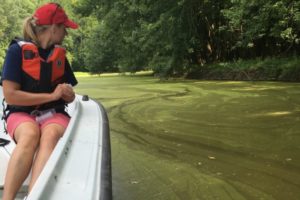
📢 Recent HAB Incident ORSANCO has released an investigation report detailing conditions observed on the Ohio River. Click here to read the full report.
ORSANCO has released an investigation report detailing conditions observed on the Ohio River. Click here to read the full report.
ORSANCO developed a Harmful Algal Bloom Monitoring (HAB), Response and Communications Plan for the Ohio River. (Available under Files.)
EPA, in partnership with ORSANCO, recently developed an app to predict HABs on the Ohio River.
Risk Characterization App for Harmful Cyanobacteria Blooms on the Ohio River
Algae are present in the Ohio River throughout the year. During optimal conditions some algae may rapidly proliferate causing a “bloom”. During a bloom the algal concentration may go from a few thousand cells per milliliter (cells/ml) of water to hundreds of thousands or even millions of cells/ml. Algae blooms are most common in the summer although they may occur at any time of the year. On the Ohio River, the conditions that allow these blooms to occur are typically low and slow flow, clear water, and warm water.
Sampling on the Ohio River has identified over 300 different species of algae. These algae are divided into 8 taxonomic divisions with the most common being diatoms (Bacillariophyta), green algae (Chlorophyta) and blue-green algae (Cyanobacteria).
Cyanobacteria can produce toxins (cyanotoxins) which can be harmful if ingested. For this reason, an algae bloom which consists primarily of Cyanobacteria is considered a HAB. These toxins can affect people and animals who ingests them, either through recreation (such as swimming), or in drinking water.
For questions about HABs or to report a bloom, please contact Greg Youngstrom &
Emilee Harmeling.
Partner HAB Programs
Illinois
Indiana
Kentucky
Ohio
Pennsylvania
West Virginia
US EPA
US ACE
Centers for Disease Control
Data From This Program
Files
| Harmful Algal Bloom Monitoring, Response and Communications Plan | Download |

